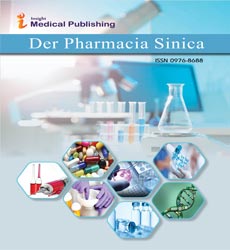ISSN : 0976 - 8688
Der Pharmacia Sinica
Pharmacokinetics: Study on Drug Absorption
Dr. Mehnaz Kamal*
Assistant Professor, Department of Pharmaceutical Chemistry, College ofPharmacy, Prince Sattam Bin Abdulaziz University, Al-Kharj 11942, Kingdom of Saudi Arabia
- *Corresponding Author:
- Dr. Mehnaz Kamal
Assistant Professor, Department of Pharmaceutical Chemistry, College ofPharmacy, Prince Sattam Bin Abdulaziz University, Al-Kharj 11942, Kingdom of Saudi Arabia
E-mail: kmehnaz23@gmail.com
Received Date: July 06, 2021; Accepted Date: July 14, 2021; Published Date: July 23 , 2021
Citation: Kamal M (2021) Pharmacokinetics: Study on Drug Absorption. Der Pharmacia Sinica, Vol.12 No.4: e009.
Safe and effective drug treatment isn't only a function of the physical and chemical properties of medicine, but also a function of how the body responds to the administration of medication. The study of the bodily processes that affect the movement of a drug within the body is called as pharmacokinetics. To know the pharmacology of medicine, the pharmacy technician must also understand the four fundamental pathways of drug movement and modification within the body.
Absorption
Absorption is that the transfer of a drug from its site of administration to the bloodstream. The speed and extent of absorption depends on the route of administration, the formulation and chemical properties of the drug, and physiologic factors which will impact the location of absorption. When a drug is run intravenously, absorption isn't required because the drug is transferred from the administration device directly into the bloodstream. Within the case of intravenous administration, the whole dose of the drug is out there to maneuver to the sites of drug action. Administration by other routes may end in less availability thanks to incomplete absorption. When this happens, less of the drug is delivered by the bloodstream to the location of action. When a tablet or capsule is swallowed it must dissolve before it is often absorbed. The dissolving of a tablet or capsule is mentioned as dissolution. Manufacturing processes and therefore the water solubility of the drug affect dissolution rates. Highly water-soluble medications dissolve more readily within the gastrointestinal (GI) tract, while fat-soluble drugs dissolve more slowly. Drugs with smaller particle sizes enter solution more readily. The inert ingredients added to formulations also can affect their dissolution. Manufacturers must avoid producing tablets so compacted that they undergo the alimentary canal without ever dissolving. Tablets that dissolve too early also are problematic, because they taste bad and are difficult to swallow. Special formulations or coatings are often wont to delay dissolution, thereby protecting the drug from stomach acid or allowing the gradual release of the drug to intentionally lengthen the absorption process. These are mentioned as delayed or sustained release formulations. Liquid preparations don't require the step of dissolution. This explains the more rapid onset of action seen with liquid formulations as compared with an equivalent drug given in tablet or capsule form. Once dissolution has occurred, the drug molecules must undergo the selectively permeable membranes of the cells lining the alimentary canal to succeed in the bloodstream. Counting on their chemical and physical properties, drugs are going to be absorbed either by passive diffusion or carrier-mediated transport across these membranes. Passive diffusion occurs when there's a high concentration of the drug on one side of the membrane and a coffee concentration on the opposite side. This difference from one side of the membrane to the opposite is named a degree gradient. It’s the natural tendency of drugs to maneuver from a neighborhood of upper concentration to a neighborhood of lower concentration; in other words, substances move down the concentration gradient. Drug molecules move across membranes or move through pores between the epithelial cells. Diffusion is most effective with drugs that are small molecules. This movement is solely driven by the K.E. within molecules, and continues until concentrations reach equilibrium. When equilibrium exists, the concentration of the substance is approximately equal on each side of the membrane. Passive diffusion doesn't involve a carrier molecule and therefore the process isn't a saturable process. Saturable processes are limited to a particular rate of activity by some aspect of the method. The overwhelming majority of medicine gain access to the blood stream by diffusion. Drugs, which are usually somewhat lipid-soluble (fat-soluble), readily move across most biological membranes. Those drugs that are highly water-soluble penetrate the cell wall through aqueous channels. Some of drugs that closely resemble present compounds are absorbed via carrier-mediated transport. This process requires carrier proteins that attach to and actively carry the drug molecules across the membrane, utilizing a natural “pump” mechanism. This method of absorption is restricted by the supply of the carrier protein and is therefore, saturable. Carrier-mediated transport requires energy and may move molecules against the concentration gradient. For an illustration of passive diffusion and carrier-mediated transport.
Open Access Journals
- Aquaculture & Veterinary Science
- Chemistry & Chemical Sciences
- Clinical Sciences
- Engineering
- General Science
- Genetics & Molecular Biology
- Health Care & Nursing
- Immunology & Microbiology
- Materials Science
- Mathematics & Physics
- Medical Sciences
- Neurology & Psychiatry
- Oncology & Cancer Science
- Pharmaceutical Sciences
